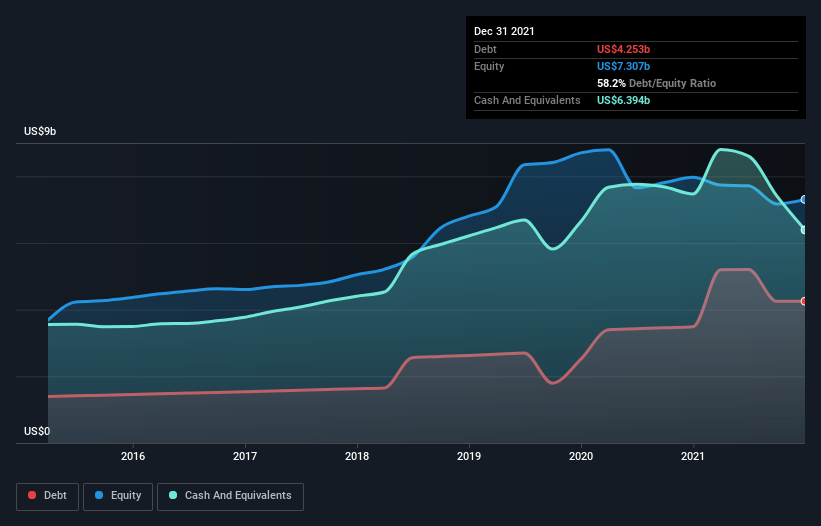- United States
- /
- Interactive Media and Services
- /
- NYSE:TWTR
Twitter (NYSE:TWTR) Could Easily Take On More Debt
Howard Marks put it nicely when he said that, rather than worrying about share price volatility, 'The possibility of permanent loss is the risk I worry about... and every practical investor I know worries about.' When we think about how risky a company is, we always like to look at its use of debt, since debt overload can lead to ruin. We note that Twitter, Inc. (NYSE:TWTR) does have debt on its balance sheet. But is this debt a concern to shareholders?
Why Does Debt Bring Risk?
Debt assists a business until the business has trouble paying it off, either with new capital or with free cash flow. If things get really bad, the lenders can take control of the business. However, a more usual (but still expensive) situation is where a company must dilute shareholders at a cheap share price simply to get debt under control. Of course, debt can be an important tool in businesses, particularly capital heavy businesses. The first step when considering a company's debt levels is to consider its cash and debt together.
View our latest analysis for Twitter
What Is Twitter's Net Debt?
The image below, which you can click on for greater detail, shows that at December 2021 Twitter had debt of US$4.25b, up from US$3.49b in one year. However, it does have US$6.39b in cash offsetting this, leading to net cash of US$2.14b.

How Healthy Is Twitter's Balance Sheet?
The latest balance sheet data shows that Twitter had liabilities of US$1.34b due within a year, and liabilities of US$5.41b falling due after that. Offsetting this, it had US$6.39b in cash and US$1.22b in receivables that were due within 12 months. So it can boast US$858.8m more liquid assets than total liabilities.
This surplus suggests that Twitter has a conservative balance sheet, and could probably eliminate its debt without much difficulty. Simply put, the fact that Twitter has more cash than debt is arguably a good indication that it can manage its debt safely.
Even more impressive was the fact that Twitter grew its EBIT by 924% over twelve months. That boost will make it even easier to pay down debt going forward. When analysing debt levels, the balance sheet is the obvious place to start. But ultimately the future profitability of the business will decide if Twitter can strengthen its balance sheet over time. So if you want to see what the professionals think, you might find this free report on analyst profit forecasts to be interesting.
But our final consideration is also important, because a company cannot pay debt with paper profits; it needs cold hard cash. While Twitter has net cash on its balance sheet, it's still worth taking a look at its ability to convert earnings before interest and tax (EBIT) to free cash flow, to help us understand how quickly it is building (or eroding) that cash balance. Over the most recent three years, Twitter recorded free cash flow worth 75% of its EBIT, which is around normal, given free cash flow excludes interest and tax. This free cash flow puts the company in a good position to pay down debt, when appropriate.
Summing up
While we empathize with investors who find debt concerning, you should keep in mind that Twitter has net cash of US$2.14b, as well as more liquid assets than liabilities. And it impressed us with its EBIT growth of 924% over the last year. So is Twitter's debt a risk? It doesn't seem so to us. When analysing debt levels, the balance sheet is the obvious place to start. However, not all investment risk resides within the balance sheet - far from it. To that end, you should be aware of the 1 warning sign we've spotted with Twitter .
Of course, if you're the type of investor who prefers buying stocks without the burden of debt, then don't hesitate to discover our exclusive list of net cash growth stocks, today.
Valuation is complex, but we're here to simplify it.
Discover if Twitter might be undervalued or overvalued with our detailed analysis, featuring fair value estimates, potential risks, dividends, insider trades, and its financial condition.
Access Free AnalysisHave feedback on this article? Concerned about the content? Get in touch with us directly. Alternatively, email editorial-team (at) simplywallst.com.
This article by Simply Wall St is general in nature. We provide commentary based on historical data and analyst forecasts only using an unbiased methodology and our articles are not intended to be financial advice. It does not constitute a recommendation to buy or sell any stock, and does not take account of your objectives, or your financial situation. We aim to bring you long-term focused analysis driven by fundamental data. Note that our analysis may not factor in the latest price-sensitive company announcements or qualitative material. Simply Wall St has no position in any stocks mentioned.
About NYSE:TWTR
Twitter, Inc. operates as a platform for public self-expression and conversation in real-time.
Mediocre balance sheet and slightly overvalued.
Similar Companies
Market Insights
Community Narratives



